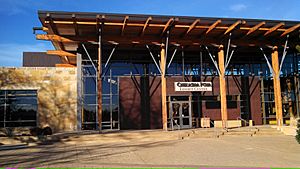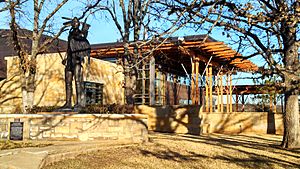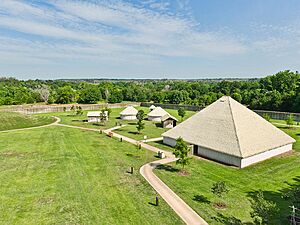Chickasaw Cultural Center facts for kids
The Chickasaw Cultural Center is a special place located in Sulphur, Oklahoma. It's close to the Chickasaw National Recreation Area. This big campus, which is about 184 acres, is home to museum buildings. These buildings have fun, interactive exhibits. You can learn about Chickasaw tribal history, traditional dancing, and the Chickasaw language.
The campus also has a village that looks just like a traditional tribal village from the past. There's also a garden that honors important members of the Chickasaw Nation. This Center is one of two museums run by the Chickasaw Nation. The other one is the First Americans Museum in Oklahoma City, Oklahoma.
Contents
History of the Center
Why the Center Was Built
In the 1960s, the leader of the Chickasaw Nation, Governor Bill Anoatubby, had an important idea. He wanted to build something to help keep the Chickasaw culture alive for future generations. At that time, the Nation wasn't ready to start such a big project.
Later, in 1980, a study was done to see if a Chickasaw-themed park could be built. The study found that there weren't enough people living nearby to make it work. In October 2000, the Chickasaw government asked over 1,200 of its members for their ideas. They wanted suggestions for what a cultural center should include.
Getting the Land and Building It
U.S. Representative Tom Cole, who is a citizen of the Chickasaw Nation, helped make a land deal. This deal was between the Nation, the City of Sulphur, and the National Park Service. It was approved on September 28, 2004. This agreement helped the Center get a great location for its campus.
The official start of construction, called a "groundbreaking," happened two days later. This was on September 30, 2004. Building the Center began shortly after that in 2004. It took six years to finish and cost $40 million. The Chickasaw Cultural Center officially opened its doors in 2010.
Exploring the Campus
The buildings and other parts of the campus were designed by an architectural group. This group is called Frankfurt Short Bruza (FSB). They have worked on many other projects with the Chickasaw Nation.
Special Exhibits
The Chickasaw Cultural Center often has different exhibits that change with the seasons. Here are a couple of examples:
- Through the Eyes of the Eagle - This exhibit is shown during Native American Indian Heritage Month (November through December). It encourages Chickasaw children to eat healthy and exercise. It's based on a series of children's books. This exhibit helps teach about and solve the problem of high rates of diabetes among Native children.
- Dynamic Chickasaw Woman Of The Year Award - This is a short presentation about the winner of this award each year. The award was created by Dr. Amanda Cobb-Greentham. It is presented during Women's History Month.
Main Buildings
- Chikasha Poya Exhibit Center - This is the main building on the campus. It holds most of the indoor exhibits where you can learn about Chickasaw history and culture.
- The Holisso Research Center - This building at the Cultural Center has a large collection of tribal records. It also has family history information about the Chickasaw people.
- Anoli’ Theater - This is the biggest theater on the campus. It can hold 350 people. It is used to show films about Native American culture. It has a very large screen, about 2,400 square feet, and uses three projectors.
- Spiritual Center - This area is used for teaching about the religious parts of Chickasaw traditions and for spiritual practices.
- Sky Pavilion Visitor Center - This building has information for visitors and a souvenir shop where you can buy gifts.
Outdoor Areas
One of the most exciting parts of the Cultural Center is the recreated traditional Chickasaw village. It looks just like a village from the past. The Center often has cultural re-enactments here. They also have daily Stomp dances in the village on the campus.
The campus also has an outdoor amphitheater for performances. There's a sky bridge that looks over the recreated tribal village. You can also find hiking trails and plants that are native to Oklahoma and Mississippi. There is also a statue created by the artist and former Oklahoma state senator Enoch Kelly Haney.




